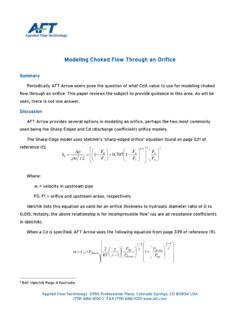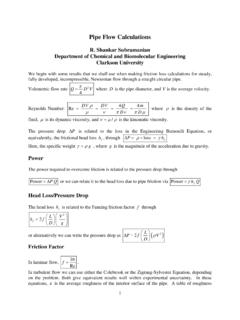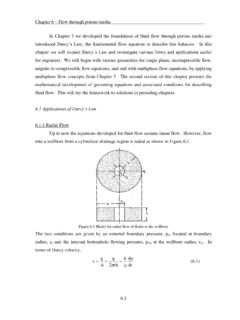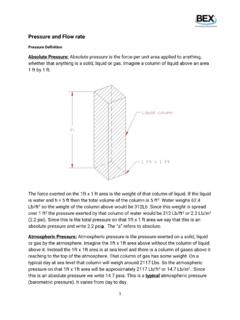Transcription of Compressible Gas Flow - Communications Site
1 Compressible Gas Flow by Elizabeth Adolph Submitted to Dr. C. Grant Willson CHE253M Department of Chemical Engineering The University of Texas at Austin Fall 2008 2 Compressible Gas Flow Abstract In this lab, Compressible gas flow through a piping system consisting of a critical flow nozzle, pressure gauges, flow meters, orifices, and a tank was observed. The critical pressure ratio (the outlet pressure divided by the inlet pressure) for choked flow through a nozzle was determined by slowly increasing the downstream pressure and observing the point at which the mass flow rate began to change. The critical pressure ratio was calculated to be , and the minimum inlet to outlet pressure ratio for choked flow was determined to be The manufacturer s performance curve for sonic flow was calibrated versus a National Institute of Standards and Technology (NIST) digital flow meter. The calibration equation was determined to be y = x , where y is the manufacturer s flow rate in lb / min and x is the NIST flow rate in lb / min.
2 The discharge coefficients of an orifice as a function of Reynolds number were determined by measuring the flow rate and pressure drop across the orifice. The discharge coefficient was calculated to be at a Reynolds number of 12700, at a Reynolds number of 18500, and at a Reynolds number of 21600. These values were about 47% larger than the literature values from Perry s Handbook. Finally, the pressure in a tank was monitored versus time as it was discharged by sonic flow through several different orifices. K , the orifice constant, was calculated from the slope of a plot of ln(P) versus time for each of four trials using orifices with known diameters. The average K was . The diameter of the unknown orifice was calculated using this experimental K and was determined to be . For an initial pressure of 90 psig and final pressure of 30 psig, the fraction of mass of air escaped from the tank was , and the absolute amount of gas escaped was g.
3 The tank discharges faster through the orifice than through the and orifices combined because the area of the orifice is larger than the sum of the areas of the and orifices (Willson, 2008). 3 Contents Introduction 2 Methods 2 Results 5 Conclusions and Recommendations 18 Appendices Appendix A: Experimental Data 19 Appendix B: Sample Calculations 22 Appendix C: Safety Considerations 28 Appendix D: Experimental Apparatus 29 References 30 List of Tables Table 1: Determination of critical pressure ratio 7 Table 2: Discharge coefficients of orifice at several Reynolds numbers 10 Table 3: Slopes, intercepts, and confidence intervals of ln(P) vs. t plots 11 List of Figures Figure 1: Visual determination of critical pressure ratio for P1 = 90 psig 5 Figure 2: Visual determination of critical pressure ratio for P1 = 70 psig 6 Figure 3: Visual determination of critical pressure ratio for P1 = 50 psig 6 Figure 4: Visual determination of critical pressure ratio for P1 = 30 psig 7 Figure 5: Calibration plot for nozzle manufacturer s performance curve 8 Figure 6: Difference between NIST and manufacturer s flow rates 9 Figure 7: Calibration of the Schaevitz strain gauge 11 Figure 8: Determination of K using orifice 12 Figure 9: Determination of K using orifice 12 Figure 10: Determination of K using orifice 13 Figure 11: Determination of K using and orifices 13 Figure 12: Determination of diameter of unknown orifice 14 Figure 13: Experimental mass of air in tank over time 15 Figure 14.
4 Tank pressure versus time for orifices of different sizes 16 Figure 15: Mass of air in tank versus time for orifices of different sizes 17 4 Compressible Gas Flow Introduction The purpose of this experiment was to measure properties of Compressible gas flow under both sonic and subsonic conditions. First, the critical pressure ratio for a critical flow nozzle was determined. The upstream temperature and pressure were kept constant and the downstream pressure was increased until the mass flow rate began to change. The nozzle manufacturer s performance curve was calibrated against the NIST-calibrated digital flow meter by calculating the choked mass flow rates predicted by the performance curve at each value of the upstream pressure and plotting them against the NIST flow rate (Willson, 2008). The discharge coefficients of an orifice meter were calculated at three different Reynolds numbers by determining the upstream pressure, upstream temperature, pressure drop across the orifice, and flow rate through the orifice.
5 These experimental discharge coefficients were compared to literature values of the discharge coefficient from Perry s Handbook (Willson, 2008). Finally, the pressure in a tank was monitored versus time as the air in the tank discharged through one or two orifices. This procedure was repeated using three orifices with known diameters and one orifice with an unknown diameter. The slopes of the plots of the natural log of pressure versus time for the known orifices were used to calculate the orifice constant K . The calculated K and the slope of the plot of ln(P) versus time for the unknown orifice were used to determine the unknown diameter (Willson, 2008). Methods The flow of air, a Compressible gas, was observed in this experiment. The density of a Compressible fluid changes with both position and time. The mass flow rate is constant because no accumulation occurs, so the volumetric flow rate and velocity of the fluid also change with position.
6 Sonic flow occurs when the velocity of the fluid equals the speed of sound in the fluid. The Mach number (M) is the ratio of the fluid velocity to the speed of sound, so sonic flow occurs when M equals one. For values of M less than one, subsonic flow occurs; for values of M greater than one, supersonic flow occurs (Willson, 2008). The apparatus consisted of a piping system with a flow meter, several pressure gauges, a differential manometer, several orifice meters, and a tank. Air was supplied through a main ball valve. A diagram of the experimental apparatus is displayed in Appendix D (Willson, 2008). In the first part of the experiment, the critical pressure ratio for sonic flow through a critical flow nozzle was determined. The critical pressure ratio is the ratio of the downstream pressure to the upstream pressure at which the flow becomes sonic. Below the critical pressure ratio, the mass flow rate is constant for a given upstream pressure.
7 The flow is choked, and it does not change if the downstream pressure is decreased. If the downstream pressure is increased so the pressure ratio is higher than the critical ratio, the mass flow rate will decrease, and subsonic flow will occur. In this experiment, the upstream pressure was kept constant, and the downstream pressure was slowly increased 5 from 0 psig. The flow rate at each downstream pressure was recorded, and a plot of mass flow rate versus pressure ratio was developed. The downstream pressure at which the flow rate first began to change was used to determine the critical pressure ratio. This procedure was repeated using four different values of upstream pressure (Willson, 2008). NIST-calibrated digital handheld manometers were used to determine the upstream and downstream pressures. These devices are strain gauge transducers with semiconductors. The change in resistance of the semiconductor is proportional to the change in pressure.
8 Also, a NIST-calibrated digital flow meter was used to monitor the flow rate of the gas. A percentage of the flow through the meter enters a stainless steel sensor tube. Heat is applied to the gas, causing the resistance of a heater sensor coil to change. The temperature-dependent resistance change is proportional to the mass flow rate through the meter (Willson, 2008). The critical mass flow rate at each upstream pressure was calculated using Equation 1, where w is the mass flow rate, P is the upstream pressure, T is the upstream temperature, and K is a function of pressure for a specific gas and nozzle. The value of K was determined using the manufacturer s performance curve provided in the lab manual. The calculated mass flow rate was compared to the flow rate determined using the NIST flow meter, and a calibration plot for the performance curve was developed (Willson, 2008). 11 TKPwCF N (1) In the second part of the experiment, Compressible gas flow through an orifice was studied.
9 An orifice is an obstruction meter used to determine the flow rate of a fluid. At the orifice, the diameter decreases to a minimum, so the velocity of the fluid reaches a maximum and the pressure reaches a minimum. Bernoulli s equation (see Equation 2) describes the energy balance across the orifice, where P is pressure, is density, V is velocity, g is the acceleration due to gravity, and h is the height. Since the pipe near the orifice was horizontal, the height difference term is zero (Willson, 2008). 2222221121112121ghVPghVP (2) Bernoulli s equation can be used to find the volumetric flow rate of the fluid. Because the air flow is Compressible , an expansion factor, Y, is used to account for the change in the density of the fluid. for gases , Y is calculated using Equation 3, where r is the ratio of the downstream pressure to the upstream pressure, is the ratio of the diameter of the orifice to the diameter of the pipe, and is the specific heat capacity ratio (Cp / Cv).
10 Although some of the pressure loss through the orifice is recovered downstream of the meter, some of it is permanently lost. Therefore, the discharge coefficient Cd is used to account for the permanent pressure loss. Equation 4 is the equation used to calculate the volumetric flow rate of a Compressible fluid through an orifice. Q is the volumetric flow rate, P is pressure, is density, and A is the area of the orifice (Willson, 2008). 6 /244/)1(/211111rrrrY (3) )1()(2412 PYACQd (4) The flow rate, upstream temperature, upstream pressure, and pressure drop across the orifice were measured at three different Reynolds numbers. These values and the diameters of the orifice and pipe given in the lab manual were used to calculate the discharge coefficient and Reynolds number of each trial. The calculated discharge coefficients were compared to the discharge coefficients given in Perry s Handbook (Willson, 2008). Finally, pressure in a tank was relieved through several orifice meters as the pressure was monitored versus time.









